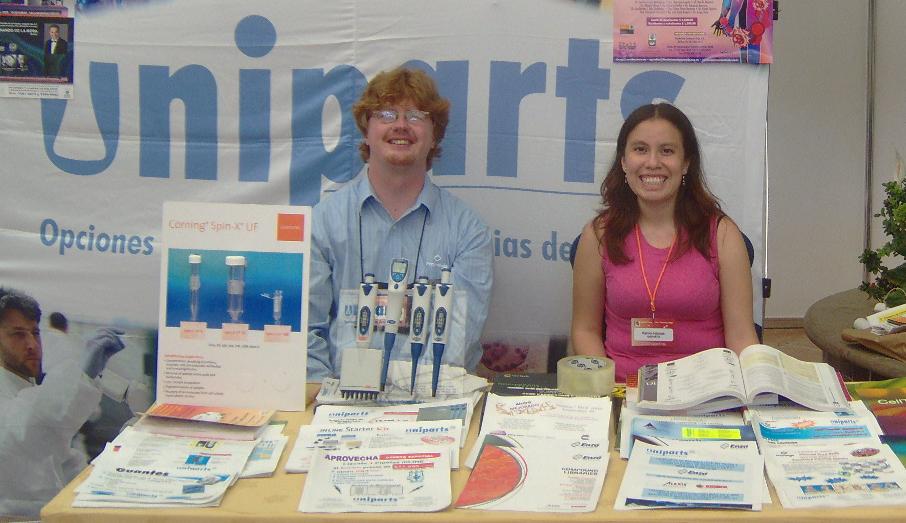Helping scientists design experiments and interpret data is what we do best at Promega Technical Services. This may mean spending time at the bench attempting to reproduce anomalous results or forming a team, perhaps with members of other departments, to brainstorm seemingly intractable experimental road blocks. Still, for many of us nothing surpasses the experience of meeting these same scientists face to face whether it be on their home turf or at a booth during a tradeshow. 
Earlier this month I traveled to Mexico for two such meetings. I had been offered the opportunity to not only present a talk on bioluminescence at the Signal Transduction Conference of the Mexican Biochemistry Society, but also to conduct a DEMO of the Promega GloMax®-Multi Detection System at Mexico’s national university (UNAM). After joining colleagues from our local distributor UNIPARTS at the airport we headed north on a two hour drive out of Mexico City to the small spa community of Ixtapan De La Sal where the conference was being held.
The keynote speaker on the opening evening of the conference was none other than Vanderbilt University’s Heidi Hamm who delivered a captivating talk on the role of GPCRs in synaptic transmission. Upstate/Millipore’s Gabriela Medina later impressed the audience with her comprehensive overview of STAR ELISA, CELISA and EZ ChIP assays. But undoubtedly the highlight of the evening was the cocktail reception that followed, during which we were treated to live music performances featuring styles from various regions of Central America.
[wpvideo DG78PQdh]
As the proceedings of the second day got under way, there was a noticeable buzz in the air over the GloMax®-Multi Detection System. We had set up the GloMax®-Multi at the UNIPARTS conference booth with the express intention of exhibiting its extensive readout capabilities. Many of those attending the conference were clearly excited to learn that, in addition to luminescence, the GloMax®-Multi instrument offered options for making fluorescence and absorbance measurements, all of this in a 96 well plate format. We had several opportunities throughout the morning to demonstrate the modular configuration of the GloMax® and the functionality of the optional dual injector system.
My afternoon presentation on bioluminescence capitalized on the interest we had garnered earlier in the day. Emphasis was placed on how luciferase reporter assays represent ‘best-in-class’ tools for studying gene regulation. Indeed the audience was extremely receptive to the message that firefly luciferase is today considered the gold standard reporter. With Promega nuclear receptor vectors and Dual-Luciferase® and Dual-Glo® Luciferase assay systems, researchers now have access to the products they need for collecting biologically-relevant data.
My colleagues and I left the Signal Transduction Conference with a deep sense of accomplishment eager to begin the second stage of our whirlwind tour. A short drive back to Mexico City, a brief stop-over for a traditional taco lunch and a further trip south through the pouring rain was all it took to reach the university town of Cuernavaca. There we were given a warm welcome by students of UNAM’s biotechnology institute as we set up the GloMax®-Multi in preparation for the instrument DEMO the following day.
Cuernavaca is a town steeped in history— a fact that becomes plainly evident to anyone visiting its downtown plazas. The Spanish conquistador Hernan Cortes built a palace there in 1532. Cuernavaca cathedral is almost as old. The more recently built state governor’s building stands tall above the small restaurants and shops that line the central square. With time running short, we had just the briefest of moments to soak in the beauty of these tourist traps before settling down to discuss last-minute revisions to our final day’s schedule.
Our plan for the instrument DEMO was simple enough- meet members of the institute, talk to them about the GloMax® technology and give them hands-on experience with the instrument. In the end our planning paid off. Using the Promega BacTiter-Glo™ Microbial Cell Viability Assay and swab samples that DEMO participants had collected, we were able to put the GloMax®-Multi through its paces. Highlights of the DEMO included showing participants how to switch between read modes, install the four fluorescence optical kits and operate the dual injector system.
Our return to Mexico City that afternoon was anything but uneventful. As news came in over the radio that Mexico had just won a soccer match against Honduras at the local Azteca Stadium, the bus erupted in cheerful celebration. Indeed driving through Mexico City in the late evening rush, it truly felt as though the throngs of people lining the streets were celebrating our return from a successful bioluminescence tour. With the blaring of horns from cars everywhere, it was hard not to imagine that we were in our own way running a victory lap for Promega’s bioluminescence technologies.
For all of us the countless hours on the road had paid rich dividends. For me, the opportunity to once more get out and meet scientists had proved to be an invaluable experience. And I admit that I did momentarily get caught up in the emotion…
Robert Deyes
Latest posts by Robert Deyes (see all)
- Royal Lessons for Scientific Discovery - October 28, 2016
- Because Timing Is Everything…. - August 18, 2014
- Grays On the Move: Whale Watching in San Diego - April 30, 2014

You might be interested in the next Signal Transduction Meeting in Mexico. This time the plan is much more ambitious. There will be 100 speakers. The Conference: Cell Signaling Neworks 2011, Merida, Yucatan, Mexico
is cosponsored by IUBMB, PABMB,SMB, ASBMB, CSBMCM and SEBBM.
Please take a look to the web page:
http://www.csn2011.com/
If possible, please share the information with those that might be interested.